9.05.2023
Some space robots barely last a year, while the Voyager probes keep trucking. What makes a space probe eternal?

Martian dust seems to have claimed another victim: China confirmed it is unable to reestablish contact with its Zhurong rover, which has been scraping around in the dirt of the Red Planet since it landed there on May 14, 2021. Approximately one year later, it entered hibernation in order to brave the harsh Martian winter and its relative lack of sunlight. But the 530 pound (240 kilogram) rover hasn't woken up, missing its December 26 deadline to send a signal back to Earth. It's been quiet ever since.
At the end of April, Beijing finally admitted that the Chinese rover was dead, likely due to accumulations of dust on its solar panels. It's a shame, because even though Zhurong far outlasted its planned life of 93 Earth days (it instead lasted an impressive 356), it made some impressive discoveries. Recently, it was announced that Zhurong had detected evidence that liquid water was flowing on Mars within the last 1.4 million years, which is relatively recent in geologic terms.
Zhurong joins a number of other Mars robots that are now inoperative, including NASA's Spirit and Opportunity rovers, which sputtered out after six years and 77 days and 14 years and 138 days, respectively. Moreover, failing space probes have been in the news lately — including the Japanese robotic spacecraft company ispace Inc. which lost contact with its probe after it likely crashed onto the Moon's surface in late April.
In contrast, NASA recently announced a plan to keep its Voyager 2 spacecraft, which was first launched more than 45 years ago, up and running for another three years at least, by dipping into its reserve fuel. How has a space probe launched in the '70s outlived so many more recent space exploration robots? The simple answer is that not all probes are equal, and failure is often just a roll of the dice away.
But looking back at the oldest, still running space probes can tell us something about the future of space exploration. We've put together a list of the longest-living space probes that are still actively sending data back.
A caveat: there are a few probes that are suspected to still be functional, yet we either don't know their location in deep space or mission control simply isn't attempting to contact them; those are not included here.
Quelle: salon
